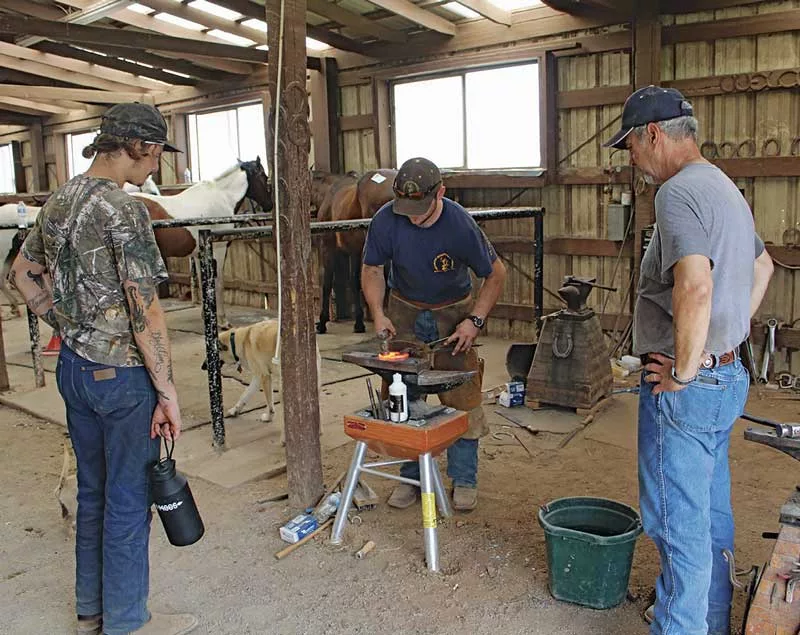Pictured Above: It’s important that students learn how to make and apply a variety of shoes including plain-stamped, sliding plates and bar shoes, as well as those that have calks and clips.
I have taught horseshoeing for more than 40 years to more students than anybody else ever has. Most of my graduates have gone on to shoe horses professionally and made a living for themselves and their families.
I have been acquainted with so many farrier teachers over the years and all of us have a somewhat different idea of what it means to teach horseshoeing. The following are my ideas of what you should learn at shoeing school.
1. Theory. You must learn the theory of horseshoeing and the physical and anatomical principles involved in farriery. It is not easy to learn, but it must be learned.
Farrier Takeaways
- Learn horseshoeing theory, as well as equine anatomy before you leave shoeing school.
- Know the shape of a “normal” horse’s hoof and appraise your work against that shape 6 weeks after the shoeing or trimming.
- Become a knowledgeable and competent horseman and be able to teach horsemanship to clients.
2. Consistency. Your progress should be monitored daily while you learn the basics. You need to learn to look for and achieve balance and appropriate angles. You should learn the shape of more or less “normal” horses’ hooves and see how that shape applies to the individual hoof that you are working on. If you learn to get the trim and shape right, then the nails almost drive themselves.
3. Horsemanship. Farriers should be good horsemen and should teach horsemanship to their clients. The farrier is the only professional who examines that horse every month or so, and clients lean heavily on your expertise. You should learn to observe if the horse is too thin, too fat, has a glossy coat or a bright look in its eye. Does the horse move well? Is it dappled? You need to know the many aspects of horsemanship that the client needs to know as it applies to their horse.
You must be taught to train a horse. I have heard it said too often that the farrier should not be expected to train the horse. I disagree. The farrier should learn to trim any horse that doesn’t stand up to be shod properly. It is safer for all concerned. It is our job and if we leave it to someone else, then we leave our safety in someone else’s hands. If you’re losing money because you’re training horses for free, then charge something for it. If the client doesn’t have to pay for the service, he or she won’t think it was worth anything.
4. How many work days in a week? It is answered in the Bible. “Six days shalt thou work and the seventh day shalt thou rest.” Work ethic needs to be developed while you’re still in school.
5. Continuing education. It is important to keep up on new information in our craft and you should develop an appreciation for education while you’re in shoeing school. Good articles can be even better than clinics because you never have to leave your clients. The farrier is responsible to be there to serve his clients’ horseshoeing needs 6 days a week.
6. Forge work. This is so necessary to the farrier that it must not be given less importance than the actual work of shoeing the hoof. I like the forge and anvil to be right across from the horseshoeing area, where it is easy to get to the forge and back to the horse. I prefer that at least 25% of the horses shod in our shop every day leave wearing handmade shoes.
You should learn to make and put on plain-punched shoes, sliding plates, calks, clips, fullered handmade shoes, bar shoes, egg-bar shoes, aluminum shoes and aluminum bar shoes.
When it is time for you to do it on your own, you should be able to light the fire and go about your work without hesitation. It should be a part of you and what you do on a regular basis.
What I Wish They’d Taught in Farrier School
We asked a number of veteran farriers to look back at their farrier school experiences and identify the one thing they wished they’d learned that would have helped their careers and would help new students get started on the right foot.
If you think the majority wished they’d spent more time on forging, trimming or modifying shoes, think again. Instead, 27% would have liked more hours on running the business side of a farrier practice. They recognized that knowing how to trim and shoe is only part of running a successful farrier business.
While farrier schools represent a fountain of knowledge, teaching time is limited, and instructors can’t teach every aspect of what it takes to become a successful farrier. But looking back, here are a few items veteran farriers felt could have helped prepare them better for their careers.
The most recent American Farriers Journal Farrier Business Practices Survey indicates 70% of full-time farriers attended farrier school for an average of 12 weeks. This was followed up with 26 months of apprenticing with a veteran farrier.
More Business Skills
Some 13% asked for more instruction on how to manage their income, while 6% would have liked to have learned how to start saving for retirement when they launched their farrier careers. Others would have liked more instruction on pricing, billing, scheduling, handling taxes and insurance.
“More on how to run a profitable business should be taught, such as how being punctual, returning phone calls and not overbooking can help your business,” says Robert Plant, a Walworth, N.Y., farrier. “Don’t be afraid to charge enough to earn a living. If a horse owner takes time off work to meet you to hold the horse, they will pay a fair price not to be stood up.”
Braham, Minn., farrier Fred Solinger agrees.
“I hear more complaints from horse owners and trainers about a lack of farrier professionalism than the quality of their hoof-care work,” he says. “Social intelligence training needs to happen in horseshoeing school, and it would be good for the industry as a whole.”
In hindsight, 20% would have liked to learn how to communicate more effectively with owners, veterinarians and trainers.
“The willingness and motivation to continually improve one’s communication skills with customers, veterinarians and other hoof- and horse-care professionals should have been taught, emphasized and directly connected to our fledgling professional farrier business,” says Clarence Crumpton Jr., a Thornburg, Va., farrier.
Graduating from school is only the beginning of your education …
“Farriers, for the most part, are poor communicators, especially when confronted by other horse professionals.”
Poor communication can mean talking too much, not talking enough, not talking concisely, not staying on point or simply not being effective enough. The ability to communicate one’s professional opinion logically, methodically and convincingly so others can understand your point of view directly affects your business’s bottom line.”
Some felt sales training would have been helpful in selling their footcare services.
In the tool area, 3% wished they had learned the importance of investing in high-quality tools right from the start. Others would have liked to learn more on how to modify tools.
“The only thing I wish I had done differently would have been to upgrade my tools from the basic- to higher-quality farrier tools right from the beginning,” says Kelly Holt, a Mabank, Texas, farrier. “Other than that, school was a great experience, and they also introduced me to a great farrier who has taught me more while driving down the road or eating lunch than you could learn from attending 10 schools.”
Only 6% thought they needed more schooling on forging skills. Even fewer mentioned the need for additional instruction on modifying shoes, biomechanics, hoof balance and other basics. Others felt there should be more emphasis on farrier safety and the importance of daily exercise in staying healthy over the long haul.
“One of the things that would have been beneficial is learning how to take care of your body,” says Clay Kobza, a Maywood, Neb., farrier. “It’s a difficult career path and we briefly covered body posture while working. Learning about exercise and other ways to keep yourself in top shape for the job that we do would have been valuable to the future farriers of the world.”
Continuing Education and Professionalism
About 10% wished there had been more guidance on the value of apprenticeships, networking with fellow farriers and securing veteran farriers to serve as mentors.
“I wish I had learned more about business and money management in school, along with how to find someone appropriate to apprentice with,” says Matt Hillegas, a Hanover, Pa., farrier. “When I went to school, we learned how to make shoes, how to shoe a horse and were then out on our own.”
Most agreed that attending farrier school is only the beginning of your hoof-care education.
“When I received my private pilot’s license my instructor told me, ‘Your pilot license is a license to learn,’” says Tad Keegan, a Sedalia, Colo., farrier. “So should your career be in shoeing horses. Graduating from school is only the beginning of your education.”
Some 17% felt instructors should place more emphasis on the importance of continuing your education throughout your career.
Others see a need for emphasizing professionalism. Several mentioned they hear more comments from horse owners about the professionalism of farriers rather than the quality of their trimming and shoeing work.
Based on this survey, many of these farriers wish they’d been taught more about the business side of shoeing. But when they were in the classroom, that’s probably not what they wanted to learn.
— Frank Lessiter, Editor







